
Rethinking Chikku Kolam for Modern Adaptation. A study on Three Dimensional interpretations of the traditional art of Chikku Kolam
1 Assistant Professor, B. Des (ID), SPA,
Jawaharlal Nehru Architecture and Fine Arts University, Hyderabad, Telangana
|
|
ABSTRACT |
||
|
Chikku Kolam is a traditional floor art practiced even today in states of Tamil Nadu, Andhra Pradesh and parts of Karnataka and Kerala. Chikku kolam emerges as a more complex form of simple rangoli patterns that are seen in different parts of the Indian subcontinent. Known with different names such as Alpana in West Bengal, Aipan in Bihar, Mandana in Rajasthan etc these patterns mostly follow simple geometric principles of symmetry, radial expansion and mirroring while highlighting a central focal point. The designs seen in these rangoli are mostly floral or nature inspired designs. In Chikku Kolam of the South Indian states, the designs become more complex making use of geometry and mathematics such as grids, algorithms and fractal expansions. The patterns also take a complex form where a single line is looped around a predetermined dotted grid in a predetermined path. The patterns are so complex that once it is made it becomes impossible to pinpoint the start and end of the loop giving rise to a pattern described as the endless knot. Yet the patterns are limitless and with their own symbolism and meaning and have various designs for different occasions and rituals. This age old art form though has been
widely studied by enthusiastic mathematicians and computer program developers
for understanding algorithms, computation and mathematical permutations and
combinations, these gridded and looped patterns have
immense potential to be explored in a 3 dimensional
form hence creating an interesting scope of study. By using modern 3d software and programs these traditional patterns can be
extruded into 3d forms creating exciting forms which
could be applied in various disciplines such as architecture, installation
art, product design etc. This research paper aims to look at these chikku kolam patterns with a
modern appreciation yet retain the cultural heritage that these patterns hold
so strongly since ages. |
|||
|
Received 15 February 2025 Accepted 20 March
2025 Published 16 April 2025 Corresponding Author Hima
Bindu Kondury, khimabindu.arch@jnafau.ac.in DOI 10.29121/granthaalayah.v13.i3.2025.6006 Funding: This research
received no specific grant from any funding agency in the public, commercial,
or not-for-profit sectors. Copyright: © 2025 The
Author(s). This work is licensed under a Creative Commons
Attribution 4.0 International License. With the
license CC-BY, authors retain the copyright, allowing anyone to download,
reuse, re-print, modify, distribute, and/or copy their contribution. The work
must be properly attributed to its author.
|
|||
|
Keywords: Traditional Art, Modern Interpretation,
Chikku Kolam, 3d Forms |
|||
1. INTRODUCTION
As the human race evolved, man always drew inspiration from his
natural surroundings to express himself. The earliest of mankind documented
their surroundings in caves as paintings of animals and rituals giving a
glimpse into his ability to observe and his need to express himself for the
others to see as form of documentation. As man evolved, his ideas and scale of
expressions also evolved gaining in grandeur like the petroglyphs seen in
various ancient sites.
As
times changed the nature worshipping man found various ways to highlight
the various rituals giving rise to a very complex set of drawing forms. The
Buddhist mandalas, the Sona sand drawings and the yantra and rangoli patterns
are just a few of the unique patterns that have become an integral cultural
aspect and hence have a profound cultural importance even in this modern world.
It's interesting to note how some of these patterns have stood the test of time
and find significance in various cultures across the globe and across
millennia. The Celtic Knot, the Swastika, Star of David are a few
patterns that can be seen regularly in various cultures across various
timelines.
The
Rangoli is one such practice that has
stood the test of time and is practiced even to this day during various rituals
and daily routine with much fervour. Known as Alpana in West Bengal, Aipan in Bihar, Mandana in Madhya Pradesh and Gujarat,
these patterns are mostly inspired by the floral or nature patterns and follow
the basic geometric principles of symmetry, radial design, emphasizing a focal
point etc.
The
Chikku Kolam practiced predominantly
in South Indian states of Tamil Nadu and Andhra Pradesh developed very unique patterns which seem to have a complex
mathematical understanding of grids, algorithms and predetermined parameters.
It's interesting to draw parallels to various patterns that might exist in
nature. This very thought is the basis for this research and as patterns in
nature are rarely seen in just two dimensions the research is based on the
thought that everything around has to be three dimensional
thus occupying a certain space.
The
method of study follows looking into similar patterns in the nature and some
profound patterns formed by mathematical interpretations, geometry and its
formulations of solid geometry, architectural built forms based on geometric
interpretations, selection of an appropriate chikku kolam pattern for 3d exploration, various 3d models
generated using the software “Blender “, 3d printing of some of the models that
can find applications in real world
1.1. Dance of the
planets and the patterns that they make
The
ancient people of the Indian subcontinent spent a good amount of time observing
the night sky and in turn the movement of the planets with reference to Mother
Earth. A lot has been written and documented about the motion of the planets
and its relevance in astronomy and astrology. It is indeed intriguing how the
patterns formed by these planetary movements (dance of the planets) which
globally came to be known as the Ptolemaic system in astronomy, is so similar to the chikku kolam. As a spiritual approach to chikku
kolam, some researchers draw conclusion between the
two wherein the “universe at the threshold” is applied at dawn as a spiritual
protection to the household.
From
the infinite space in the universe to the movement of electrons around the
central nucleus in atoms, the pattern tends to follow the geometry of the chikku kolam, symmetry, radial
expansion and an endless knot in which it is difficult to determine the
starting and ending of the loop. The picture below gives the images or patterns
formed by the movement of various planets with respect to Earth.
Figure 1

|
Figure 1 Patterns Formed by Revolution
of Planets with Ref to Earth |
1.2. Chladni plate
sound vibrations and Lissajous
curves.
Other
interesting patterns that are created naturally and can be compared to chikku kolam are the sound
patterns made by fine sand on Chladni plates. In an interview after her
exhibition titled “Rangoli and Resonance Art”, art scholar Kumuda Krovvidi says “I have used sound frequencies to bring
attention to universal patterns that correlate to those sound frequencies.
These patterns are found in all of our surroundings,
in snowflakes, in nautical shells, in animal life and plants in our Universe.”
She further adds that what makes her study unique is the correlation of sound
frequency patterns with chikku kolam.
Chikku kolam patterns are usually created from a
graph of dots that enable the geometry to remain intact and are amazingly like
the meticulous records of patterns studied by physicists. Chaldni
plates make it possible to visualize sound frequencies as patterns. The study
of visual sound is called Cymatics and sound actually has a distinct geometry, much like crystals and
flowers and nautilus shells. A striking similarity can be seen between these
sound patterns and chikku kolam
giving us an opportunity to look at these vibrations and behaviour of sound in
a 3 dimensional format. (Sridhar).
This
concept can be further understood by the Lissajous curves. Lissajous curves or
Bowditch curves can be described as an infinite number of curves that formed by
intersecting of two simple sound oscillations that are perpendicular to each
other i.e. the X and the Y planes. An intricate mesh like pattern is achieved
when both the sound waves are of different frequencies which are very similar
to the predetermined patterns of Chikku Kolam. Its
interesting to note that when a third frequency is introduced to the Lissajous
patterns, a very intricate three dimensional
structures are formed. These three dimensional
patterns are the basis for this study as the patterns formed are very similar
to the chikku kolam
patterns making one wonder if our ancestors had a deep knowledge of the mathematical
and scientific implications of sound waves in pattern formations and if they
did it would be interesting to look at these chikku kolam as three dimensional forms.
The picture below gives the correlating patterns of Chaldni
plate sound vibrations and chikku kolam.
The 3d image is of Lissajous curves of three varing
sound waves that has been 3d printed.
Figure 2

|
Figure 2 Chaldni Plate Patterns |
Figure 3

|
Figure 3 Lissajous
Pattern In 3D |
1.3. Understanding
Geometry in Chikku Kolam
In
their research paper “Fundamental Study on Design System of Kolam
Pattern”, Yanagisawa and Nagata, talk of understanding the fundamental
geometrical principles of Chikku Kolam from a morphological view
point. They have managed to list out the various rules that are followed
in making the kolam patterns and make use of computer
aided calculations to determine the number of patterns that can be generated
for a grid of predetermined parameters.
As
per their computational generation, the various patterns that can be derived in
a 1,7,1 grid and the geometrical principles are listed
as below
Total
number of patterns 68,719,476,736
Of
them, One-strple 11,661,312 (0.017%)
Of
them, Unique 1,458,430
Of
them, Symmetrical 1,520
1-axial
884
180°
rotational 612
90°
rotational 12
2-axial
+ 180° rotational 12
Figure 4

|
Figure 4 These are Symmetrical Patterns
with Both Vertical and Horizontal Symmetry |
Figure 5

|
Figure 5 These Patterns are Highly
Symmetrical with 90 Degree Rotation |
Kolam
patterns have such a clear and interesting design system, that countless
various one-stroke patterns can be drawn following extremely simple elements
and a few simple drawing rules. Large and complicated ones are also designed by
joining small patterns based on a simple framework. These characteristic
features of Kolam patterns have prospects to be applied to other areas, such as
toy, puzzle game, tiling design, graphical language, architecture and city
planning.
1.4. Understanding
various methods of extruding 2d forms into 3d forms.
It's
important to understand the progress that we have made in geometry and
mathematics over ages and to understand the thoughts and methods that great
thinkers have applied over years to actually understand
how the 2d patterns can have a whole new meaning when explored in 3 dimensional space.
1.4.1. Euclidean
Geometry
Greek mathematician Euclid, in his book “Book of
Elements” formulated the axioms and theorems for solid geometry which came to
be known as Euclidian Geometry. Euclid spoke of formulae by which any regular
polygon could be visualize as a three dimensional
polyhedron depending on a set of axioms.
Regular
polyhedra are the solid analogies to regular polygons
in the plane. Regular polygons are defined as having equal (congruent) sides
and angles. In analogy, a solid is called regular if its faces are congruent
regular polygons and its polyhedral angles (angles at which the faces meet) are
congruent. This concept has been generalized to higher-dimensional (coordinate)
Euclidean spaces. Whereas in the plane there exist (in theory) infinitely many
regular polygons, in three-dimensional space there exist exactly five regular polyhedra. These are known as the Platonic solids:
1)
the tetrahedron, or pyramid, with 4 triangular faces
2)
the cube, with 6 square faces
3)
the octahedron, with 8 equilateral triangular faces
4)
the dodecahedron, with 12 pentagonal faces
5)
the icosahedrons, with 20 equilateral triangular faces
Figure 6

|
Figure 6 Platonic Solids |
With
the development of various 3d modeling software a
wide variety of three dimensional forms can be
generated keeping intact the principles of Euclidean Geometry but with variable
parameters. The picture shown below gives a
idea of how a given dodecahedron can be designed into various
different forms by varying the parameters.
Figure 7

|
Figure 7 3D Adaptation of Platonic
Solids |
1.4.2. Analytic
Geometry in Three Dimensions
The
Cartesian plane in Analytic Geometry is defined by two perpendicular number
lines, the X-axis and Y-axis, which form the foundation for two-dimensional
patterns. To locate a point in space, a third dimension, the Z-axis, is
introduced, forming the basis of solid analytic geometry. Analytical Geometry
combines algebra and geometry, representing geometric figures through algebraic
equations in either a two-dimensional coordinate system or three-dimensional
space. In a three-dimensional coordinate system, the X, Y, and Z axes define
three planes: the XY plane, the XZ plane, and the YZ plane. These coordinate
planes divide the space into eight octants, with the first octant containing
all positive coordinates. Since Chikku kolam patterns
have a well defined X and Y
coordinates it’s interesting to see how these can be superimposed and studied
in the third Z coordinate.
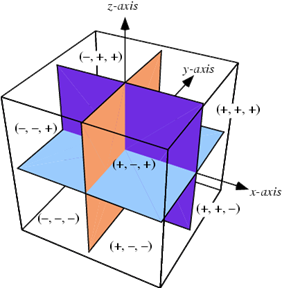

1.5. Geometry and
Design
A
branch of computational geometry known as geometrical design, deals with
construction and representation of free form curves, surfaces or volume and is
a precursor to geometric modeling. With the
advancements of complex modeling software geometric modeling can be built for objects of any dimensions in any
geometric space. Both 2D and 3D geometric models are extensively used in
computer graphics, typology and technical drawings.
At
the core of architectural design and research is architectural geometry which
looks at design, analysis and manufacturing processes. With the use of these
software architectural geometry can now explore various forms in contrast to
the traditional forms and is being strongly influenced by various
different fields such as differential geometry, topology, fractal
geometry etc. To reach to a substantial understanding of these new forms it is
necessary to look at some of the works of great thinkers, designers and artists
who have put forward formulations for new and unique architectural designs.
1.5.1. Geometry in
Ancient Indian Temples
In
her paper “Parametrizing Indian Kanata – Dravida Temples using Geometry”,
author Sruti Goud gives a great understanding of the geometrical axioms applied
in the complex temple designs of the Sanghmeshwara
Temple emphasizing on the correlation between parametric extrusion of the
temple design and ornamentation and the vastumandala
principles for construction and ornamentation.
Figure 8
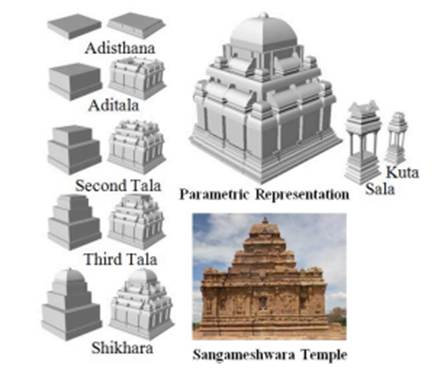
|
Figure 8 Parametric Understanding of Sanghmeshwara Temple |
1.5.2. Leonardo De
Vinci - exploration in geometry
It
becomes important to note how great artists have explored geometry to
understand proportion and beauty. Leonardo De Vinci is the most noteworthy name
that comes to mind when we speak of sacred geometry and his immense body of
work gives us an insight to look into forms and their 3 dimensional development. Its uncanny to note when one
follows the principles of geometry or the nature’s laws of harmony there seems
to be a similarity to everything around and also to
the Chikku Kolam.
The
following figures talk of how computational and parametric thinking can be
applied to De Vinci’s sketches of various churches to see how the process of
design and 3d forms takes shape. Its interesting to
note the similarity between the ancient temple architecture and the church
design where the principles of extrusion and geometry remain the same.
Figure 9
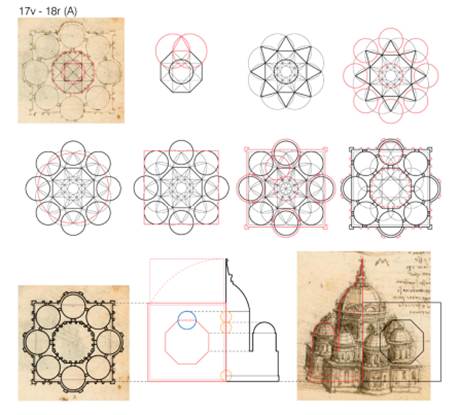
|
Figure 9 3D Extrusion of Churches Explored by Da Vinci in His Drawings |
1.5.3. Antonio Gaudi -
Parametric Approach to built forms.
Antonio
Gaudi and Frei Otto are the prominent designers in the realm of parametric
design. Gaudi’s intricate catenary arches which he shaped by inverting the
forms with upside – down models of churches and were the first in parametric
design. He relied on analog computing – achieved this
by suspending weighted strings and transforming the catenary arches by
adjusting the positions of the weights. A mirror placed below reflected the
model offering an intriguing design for the church.
Frei
Otto experimented in parametric designs by employing form – finding activities
derived from soap films and paths. He dabbled with free form structures using
hanging models and water bubbles, expanding the design horizon with his
experimental approaches.
Figure 10
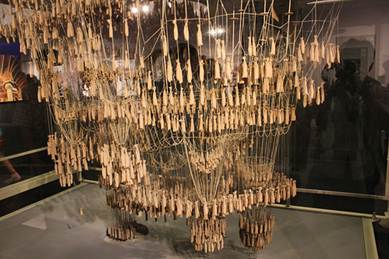
|
Figure 10 Design Development Model of Sagrada
Familia by Gaudi |
Transitioning
into the modern era, Zaha Hadid emerged as a potent force, propelling
parametric design into the architectural mainstream. With audacious and
futuristic designs, Hadid unleashed a new wave in architecture. Her
architectural marvels such as the Guangzhou Opera House and the London Aquatics
Centre reflected the transformative power of parametric design. Echoing dynamic
flowing forms, these structures seamlessly blended within their settings,
offering a distinctive visual appeal.
2. FINDINGS AND
DISCUSSION
Exploring
3 dimensional Chikku Kolam
Figure 11

|
Figure 11 Selected Chikku Kolam Pattern |
The
above kolam is the pattern selected for the
exploration of 3d extrusions.
As
seen in the study of the research the various patterns that can be derived in a
1,7,1 grid. The various patterns and the geometrical principles are listed as
below
Total
number of patterns 68,719,476,736
of
them, One-strple 11,661,312 (0.017%)
of
them, Unique 1,458,430
of
them, Symmetrical 1,520
1-axial
884
180°
rotational 612
90°
rotational 12
2-axial
+ 180° rotational 12
Though
the possibility for a 1-7-1 grid chikku kolam is endless, the pattern selected serves as good
example as it follows most of the geometric principles of a traditional chikku kolam
·
It is formed by a continuous looped string which runs around the
dotted grid to end at the starting point hence forming something known as the
“Endless Knot”
·
The pattern is perfectly symmetrical on both the vertical axis and
the horizontal axis.
·
The pattern could serve as a good case study as the loops that are
formed cover a larger space in contrast to the loops quickly circling a single
dot.
The
following table gives the possible 3d extrusions that have been generated using
various methods of 3d generation.

3. OBSERVATIONS
The three-dimensional exploration of the selected Chikku Kolam gave
some interesting 3D forms that can find application in various fields such as
product design, architecture, interior design, urban design etc. A detailed
observation of various forms is listed below:
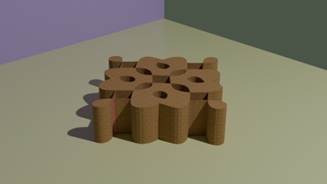
1)
Rounded and Modular Forms – The structure consists of multiple interconnected,
cylindrical extrusions with smooth transitions, giving it an organic and
natural aesthetic.
2)
Perforated Surface – The top surface features evenly spaced, rounded holes,
suggesting a procedural or generative design approach.
3)
Uniform Height Variation – Unlike sharp or highly irregular extrusions, this one
maintains a relatively consistent height, with soft undulations instead of
dramatic peaks or spikes.
4)
Voxelized or
Computational Approach – The design resembles patterns created using implicit modeling, metaballs, or cellular
automata-based extrusions, often seen in architectural or computational
design workflows.
This
style is commonly employed in biomorphic architecture, generative design,
and digital fabrication techniques like 3D printing or CNC milling.
The following images are those of 3D printed models
using pla material.

The
extrusion style used in the image appears to be variable-height or
procedural extrusion, where the height of the extruded elements is
determined by an underlying pattern or function. The structure follows these
characteristics:
1)
Contour-Based Extrusion – The height of the vertical extrusions varies according to
a predefined 2D shape or pattern, possibly a calligraphic or waveform-like
design.
2)
Columnar or Cylindrical Segmentation – The
extrusion is composed of multiple vertical segments, resembling cylinders or
elongated prisms, rather than a continuous surface.
3)
Parametric or Algorithmic Approach – The
smooth flow of curves and sharp spikes suggests the use of a procedural
generation technique, often seen in parametric modeling
or data-driven extrusion in 3D software like Blender, Grasshopper (Rhino), or
Houdini.
This
technique is commonly used in generative art, typography-based 3D modeling, and sound wave visualizations.
The following images are those of 3D printed models
using pla material

The
extrusion style in the above image appears to be a twisted, parametric, and
faceted extrusion, characterized by:
1)
Helical or Twisting Motion – The structure features a dynamic, swirling form,
suggesting a rotational extrusion technique where a base shape is extruded
along a spiraling or twisting path.
2)
Faceted, Low-Poly Geometry – The surface has a sharp, angular, and polygonal
appearance, indicating a low-resolution mesh or intentional faceting to enhance
the sculptural quality.
3)
Procedural or Algorithmic Generation – The
controlled yet complex form suggests the use of parametric modeling
tools such as Grasshopper (Rhino), Houdini, or Blender’s modifiers (Twist,
Subdivision, or Lattice Deform).
This
extrusion technique is commonly used in generative architecture, 3D-printed
sculptures, kinetic forms, and experimental computational design.
3D printing of this model was not feasible as the
structure is complicated and the software used (Blender) was showing multiple
errors for 3D printing.
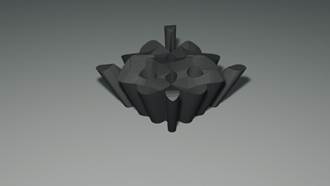
The
extrusion style in the above image appears to be contour-based organic
extrusion with the following characteristics:
1)
Smooth but Faceted Surface – The model has an undulating yet polygonal surface,
suggesting a low-resolution mesh extrusion or intentional faceting for a
sculptural aesthetic.
2)
Vertical Growth with Variable Heights –
Some sections extend further upwards than others,
indicating a non-uniform extrusion height based on underlying contours
or parametric control.
3)
Organic and Wave-like Deformation – The
edges have a rounded, flowing curvature, likely influenced by a smooth
procedural modifier like SubD or Laplacian
Smoothing.
4)
Perforations and Cutouts – The presence of circular voids suggests an
interplay between subtractive modeling (Boolean
operations) and extruded forms.
This
type of extrusion is commonly seen in computational design, 3D-printed
architectural models, and organic parametric structures. It might have been
created using tools like Grasshopper (Rhino), Blender, or Houdini,
leveraging procedural height maps or contour-based extrusions.
The following images are those of 3D printed models
using pla material

The
model has been enhanced for the purpose of 3D printing as the software
generated model seemed rough and unfinished. The extrusion principle has been
retained.
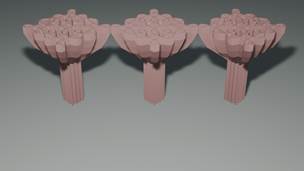
The
extrusion style in the above image appears to be modular, voxel-based
extrusion with the following characteristics:
1)
Columnar Growth Structure – The extrusion extends vertically in a tree-like or
mushroom-like formation, with clustered circular extrusions forming the
"canopy" and elongated cylindrical extrusions forming the
"trunks."
2)
Stacked, Step-Like Layers – The surfaces have a clear stepped or layered effect,
indicating the use of contour-based height mapping or a low-resolution
voxel-style extrusion.
3)
Hexagonal or Circular Module-Based Geometry – The
extrusions are arranged in a repeating, geometric pattern, possibly
influenced by cellular automata, parametric design, or a procedural growth
algorithm.
4)
Bridge-Like Connection Between Structures – The
connections between the three main extrusions suggest a generative algorithm
that links modules dynamically, possibly simulating organic growth or
branching.
3D
printing for this model has not been explored due to the scale and intricacy of
the design.

The
extrusion style in the above image appears to be a parametric freeform
lattice extrusion, featuring the following characteristics:
3.1. Key Features of the Extrusion Style
1)
Organic, Flowing Frame Structure
·
The framework consists of smooth, curved, and looping
elements, suggesting a parametric algorithm was used to generate the
shape.
·
The black structural frame follows fluid, freeform curves,
giving it an organic, sculptural appearance.
2)
Surface-Based Extrusion with Wire Detailing
·
The inner mesh structure is made of thin, red curving
wire-like lines, resembling a woven or networked pattern.
·
This suggests the use of secondary parametric elements
to fill the primary structure.
3)
Asymmetric, Canopy-Like Form
·
The design lacks symmetry and appears to be inspired by tensile
or pavilion-like structures.
·
The overall geometry is reminiscent of biomimicry-based
architectural forms, such as tree canopies or insect wings.
4)
Supported by Vertical Columns
·
Unlike previous images, this structure is held up by vertical
posts, indicating a partially suspended or pavilion-like function.
5)
Extrusion Techniques Used:
·
Profile Extrusion Along Curves:
1)
The thick black outlines suggest that curves were first
drawn and then extruded along a path.
·
Surface-Based Meshing:
2)
The inner fine wire patterns were likely created using a Voronoi,
network, or L-system growth algorithm.
The
form looks like it was projected onto a non-planar surface, possibly
with Rhino + Grasshopper, Houdini, or Blender Geometry Nodes.
3D
printing of this structure was not executed because of the difficulty and
failure of the structure.
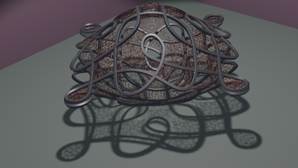
The
extrusion style in the above image appears to be organic, curvilinear
parametric extrusion with the following characteristics:
3.2. Key Features of the Extrusion Style:
1)
Ribbon-Like Structural Extrusions – The
dominant form consists of thick, looping curves that appear to be tubular
splines or NURBS-based extrusions, following a fluid, interconnected
pattern.
2)
Wireframe-Like Inner Structure – The
interior contains a finer network of thin, chaotic wire-like elements,
possibly generated using a particle-based growth algorithm or randomized
curve extrusions.
3)
Dome-Like Overall Form – The general shape suggests an arching, semi-spherical
structure, often seen in biomorphic architecture, tensile structures, or
procedural parametric designs.
The following images are those of 3D printed models
using pla material

The
framework like inner membrane was difficult to 3D print. The structure has also
been modified by printing only the above half as the dome like structure would
find appropriate function in real world scenario. Any light fabric like
covering would go perfectly with the structure.
As this dome like form serves the purpose of a
structure to cover a certain space and yet keeping in mind the aesthetical and
cultural importance of Chikku Kolam, the method of the extrusion has been
considered for further study. A more complex Chikku Kolam pattern has also been
explored in a similar fashion image of which have been shares below:

The
above images are 3D models generated using the software
Blender.
The
3D printed models of the same are as below:

The
following study of 3D extrusions gives us an idea of creating a module of a 3D
form that can be replicated as per the requirement to cover a certain area, a
structure that can be employed to cover various pockets of space such as public
spaces in urbanscapes, exhibition spaces etc.
4. Conclusion
The art of Chikku Kolam is of great significance in the South Indian states of Tamil Nadu, Andhra Pradesh and Telangana. It is indeed mesmerizing to note how these complex geometric patterns that follow various principles of geometry are meticulously recorded and handed down since generations by the women and the young girls of the household. This knowledge of generating such complex patterns is slowly vanishing from the busy urbanized cities and does require efforts to be conserved and protected and also find newer ways of finding relevance in the urbanized cities. Blending technology and tradition together is the way ahead to foray in terms of design and architecture.
CONFLICT OF INTERESTS
None.
ACKNOWLEDGMENTS
I would like to thank my student, Saifuddin Khwaja for his immense support in generating the 3D models and also in 3D printing of the same. I also take this opportunity to thank my student, Meghnath Naidu for his help with the 3D model generation. This paper is part of the research grant provided by the University, SPA, Jawaharlal Nehru Architecture and Fine Arts University, Hyderabad. I would also like to mention the use of Meta AI for streamlining the thought process for this paper.
REFERENCES
Britannica. (2024). Knot Theory | Mathematics & Topology. Retrieved 2024, September 18.
Illustrarch. (n.d.). What is Parametric Architecture and Who are the Pioneers?
Nagata, S., & Yanagisawa, K. (2007). Fundamental Study on Design System of Kolam Pattern.
Goud, S. (n.d.). Parametrizing Indian Karnata-Dravida Temple Using Geometry.
Sengupta, S.
(2019). Kolam Traditions in South India. DK Printworld.
Shankar, A. K. (2016). Pulli Kolam and the Creative Mind. Palaniappa Brothers.
Star in the Stone. (n.d.). Ernst Haeckel.
Storm Math. (n.d.). Precalculus - Chapter 11.
Wikipedia. (2024, December 1). Geometric Design.
Wikipedia. (n.d.). Geometric Design. Retrieved 2024, December 1.
Wikipedia. (n.d.). Lissajous Curve. Wikipedia, The Free Encyclopedia.
 This work is licensed under a: Creative Commons Attribution 4.0 International License
This work is licensed under a: Creative Commons Attribution 4.0 International License
© Granthaalayah 2014-2025. All Rights Reserved.